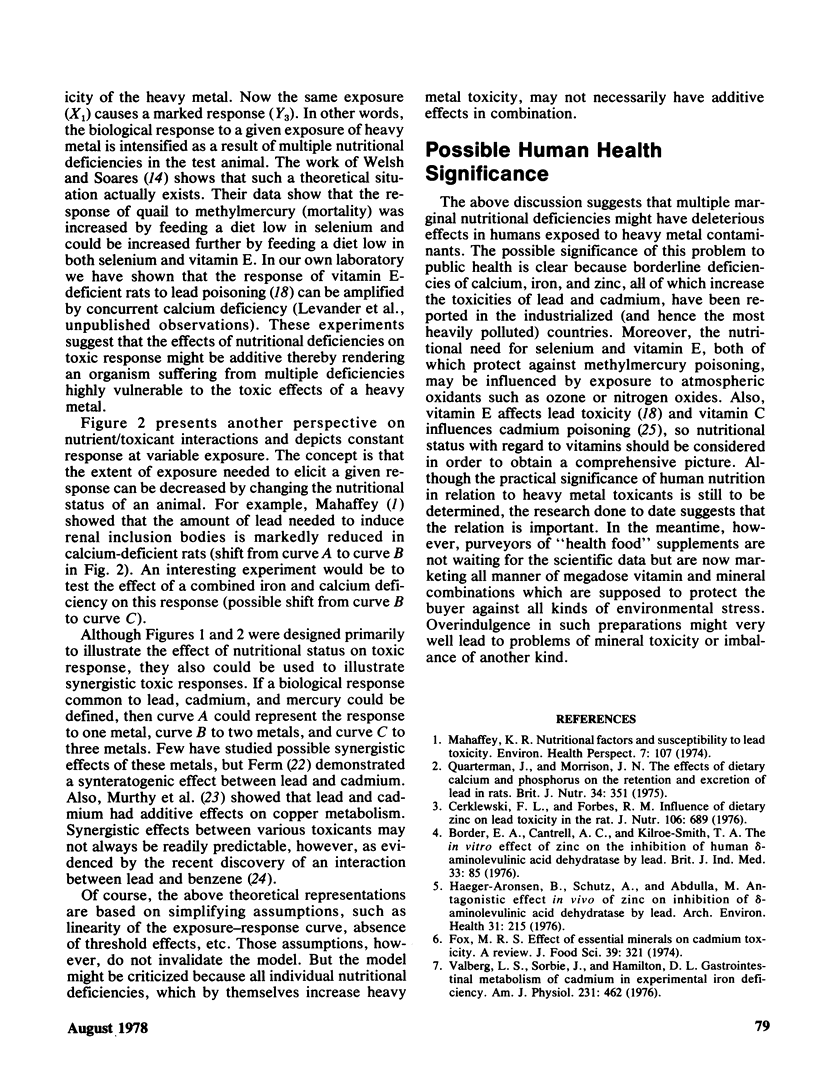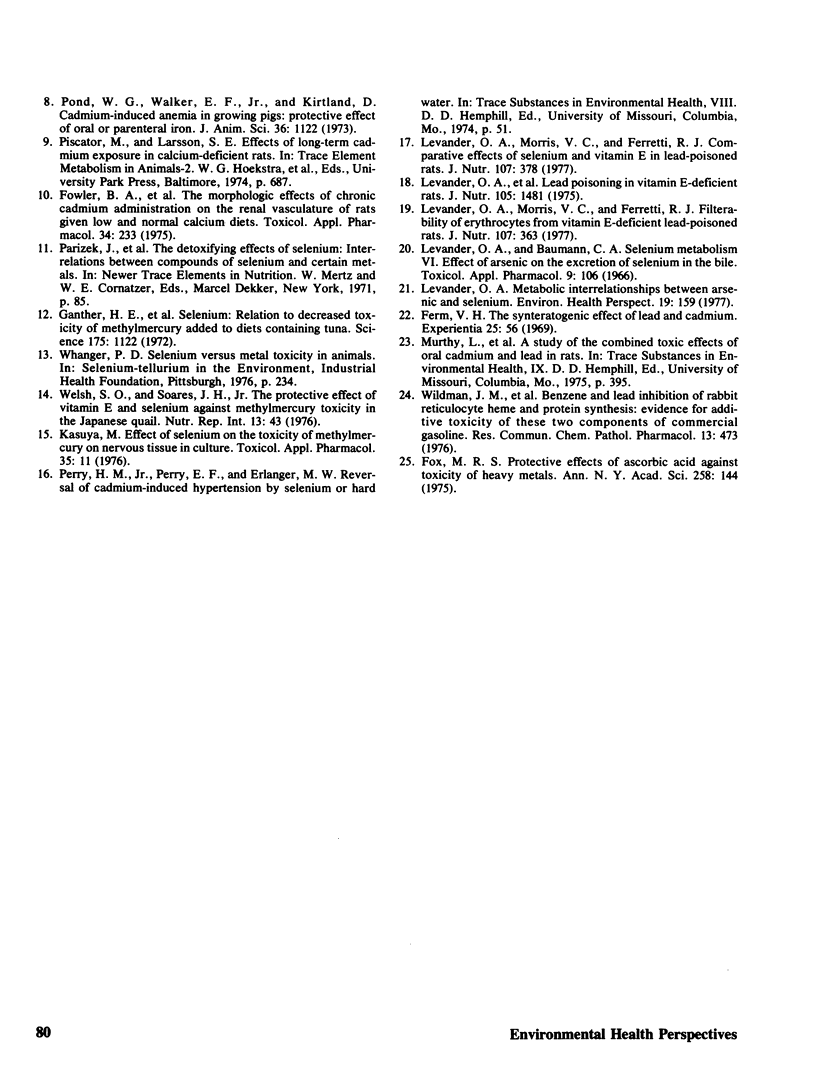Abstract
The experimental evidence obtained with laboratory animals which shows that the toxicities of lead, cadmium, and mercury can be increased by deficiencies of certain essential nutrients such as calcium, iron, zinc, and selenium is briefly reviewed. An idealized theoretical model which indicates the possible influence of multiple nutritional deficiencies on the toxicity of a heavy metal is presented. It is suggested that multiple marginal nutritional deficiencies may be of importance in determining the response of humans to the toxic effects of various heavy metal pollutants.
Full text
PDF



Selected References
These references are in PubMed. This may not be the complete list of references from this article.
- Border E. A., Cantrell A. C., Kilroe-Smith T. A. The in vitro effect of zinc on the inhibition of human delta-aminolevulinic acid dehydratase by lead. Br J Ind Med. 1976 May;33(2):85–87. doi: 10.1136/oem.33.2.85. [DOI] [PMC free article] [PubMed] [Google Scholar]
- Cerklewski F. L., Forbes R. M. Influence of dietary zinc on lead toxicity in the rat. J Nutr. 1976 May;106(5):689–696. doi: 10.1093/jn/106.5.689. [DOI] [PubMed] [Google Scholar]
- Ferm V. H. The synteratogenic effect of lead and cadmium. Experientia. 1969 Jan 15;25(1):56–57. doi: 10.1007/BF01903893. [DOI] [PubMed] [Google Scholar]
- Fowler B. A., Jones H. S., Brown H. W., Haseman J. K. The morphological effects of chronic cadmium administration on the renal vasculature of rats given low and normal calcium diets. Toxicol Appl Pharmacol. 1975 Nov;34(2):233–252. doi: 10.1016/0041-008x(75)90028-9. [DOI] [PubMed] [Google Scholar]
- Fox M. R. Protective effects of ascorbic acid against toxicity of heavy metals. Ann N Y Acad Sci. 1975 Sep 30;258:144–150. doi: 10.1111/j.1749-6632.1975.tb29274.x. [DOI] [PubMed] [Google Scholar]
- Ganther H. E., Goudie C., Sunde M. L., Kopecky M. J., Wagner P. Selenium: relation to decreased toxicity of methylmercury added to diets containing tuna. Science. 1972 Mar 10;175(4026):1122–1124. doi: 10.1126/science.175.4026.1122. [DOI] [PubMed] [Google Scholar]
- Haeger-Aronsen B., Schütz A. Antagonistic effect in vivo of zinc on inhibition of delta-aminolevulinic acid dehydratase by lead. Arch Environ Health. 1976 Jul-Aug;31(4):215–220. doi: 10.1080/00039896.1976.10667222. [DOI] [PubMed] [Google Scholar]
- Kasuya M. Effect of selenium on the toxicity of methylmercury on nervous tissue in culture. Toxicol Appl Pharmacol. 1976 Jan;35(1):11–20. doi: 10.1016/0041-008x(76)90106-x. [DOI] [PubMed] [Google Scholar]
- Levander O. A., Baumann C. A. Selenium metabolism. VI. Effect of arsenic on the excretion of selenium in the bile. Toxicol Appl Pharmacol. 1966 Jul;9(1):106–115. doi: 10.1016/0041-008x(66)90035-4. [DOI] [PubMed] [Google Scholar]
- Levander O. A. Metabolic interrelationships between arsenic and selenium. Environ Health Perspect. 1977 Aug;19:159–164. doi: 10.1289/ehp.7719159. [DOI] [PMC free article] [PubMed] [Google Scholar]
- Levander O. A., Morris V. C., Ferretti R. J. Comparative effects of selenium and vitamin E in lead-poisoned rats. J Nutr. 1977 Mar;107(3):378–372. doi: 10.1093/jn/107.3.378. [DOI] [PubMed] [Google Scholar]
- Levander O. A., Morris V. C., Ferretti R. J. Filterability of erythrocytes from vitamin E-deficient lead-poisoned rats. J Nutr. 1977 Mar;107(3):363–372. doi: 10.1093/jn/107.3.363. [DOI] [PubMed] [Google Scholar]
- Levander O. A., Morris V. C., Higgs D. J., Ferretti R. J. Lead poisoning in vitamin E-deficient rats. J Nutr. 1975 Nov;105(11):1481–1485. doi: 10.1093/jn/105.11.1481. [DOI] [PubMed] [Google Scholar]
- Mahaffey K. R. Nutritional factors and susceptibility to lead toxicity. Environ Health Perspect. 1974 May;7:107–112. doi: 10.1289/ehp.747107. [DOI] [PMC free article] [PubMed] [Google Scholar]
- Pond W. G., Walker E. F., Jr, Kirtland D. Cadmium-induced anemia in growing pigs: protective effect of oral or parenteral iron. J Anim Sci. 1973 Jun;36(6):1122–1124. doi: 10.2527/jas1973.3661122x. [DOI] [PubMed] [Google Scholar]
- Quarterman J., Morrison J. N. The effects of dietary calcium and phosphorus on the retention and excretion of lead in rats. Br J Nutr. 1975 Nov;34(3):351–362. doi: 10.1017/s0007114575000414. [DOI] [PubMed] [Google Scholar]
- Valberg L. S., Sorbie J., Hamilton D. L. Gastrointestinal metabolism of cadmium in experimental iron deficiency;. Am J Physiol. 1976 Aug;231(2):462–467. doi: 10.1152/ajplegacy.1976.231.2.462. [DOI] [PubMed] [Google Scholar]
- Wildman J. M., Freedman M. L., Rosman J., Goldstein B. Benzene and lead inhibition of rabbit reticulocyte heme and protein synthesis: evidence for additive toxicity of these two components of commercial gasoline. Res Commun Chem Pathol Pharmacol. 1976 Mar;13(3):473–488. [PubMed] [Google Scholar]


